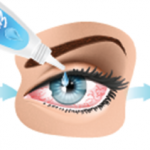 New research suggests novel markers of dry eye disease can be found in the lacrimal fluid and tear fluid of patients. Jae Hun Jung, PhD, of Yonsei University College of Medicine in South Korea, and colleagues used in-depth proteomic analysis to compare tear fluid and lacrimal fluid proteins from patients with dry eye disease and healthy controls. They published their results online Oct. 17 in Scientific Reports. Their research focused on protein levels and did not compare expression patterns at the gene level in different tissues.1
New research suggests novel markers of dry eye disease can be found in the lacrimal fluid and tear fluid of patients. Jae Hun Jung, PhD, of Yonsei University College of Medicine in South Korea, and colleagues used in-depth proteomic analysis to compare tear fluid and lacrimal fluid proteins from patients with dry eye disease and healthy controls. They published their results online Oct. 17 in Scientific Reports. Their research focused on protein levels and did not compare expression patterns at the gene level in different tissues.1
The investigators began their study by pooling tear fluid (n=5) and lacrimal fluid (n=5) samples from patients and comparing them with a similar pooling of samples from controls. They analyzed the proteins in the samples by liquid chromatography MS (LC-MS/MS) and found that approximately half of the detected proteins were common between tear fluid and lacrimal fluid. When the investigators looked more closely at the non-shared proteins, they identified 16 marker proteins of dry eye disease, three of which were upregulated in tear fluid, eight of which were upregulated in lacrimal fluid and five of which were down regulated in lacrimal fluid.
The researchers then performed Gene Ontology–Biological Processes (GO-BP) and Kyoto Encyclopedia of Genes and Genomes (KEGG) pathway analyses to specifically look at the cellular components of tear fluid and lacrimal fluid proteins. They found the cellular pool of tear fluid proteins comprised mostly extracellular region proteins, whereas the cellular pool of lacrimal fluid proteins comprised largely cytosol proteins. Additionally, the GO-BP category of immune/inflammatory response process was actively changed in lacrimal fluid, but not in tear fluid. More specifically, the most upregulated proteins in the lacrimal fluid belonged to the GO-BP category of immune response.
“In this study, we identified a larger number of proteins in [lacrimal fluid] than in [tear fluid] (1,448 vs. 1,165), although [tear fluid] contains a greater number of different cells, such as the corneal epithelium, immune cells, nerves, vascular cells, Goblet cells and Meibomian gland cells,” write the authors in their discussion. “Moreover, approximately half of the identified proteins (849) were common between [tear fluid] and [lacrimal fluid]. These results indicate that 316 [tear fluid] proteins were not secreted from the [lacrimal gland ] and that the [lacrimal gland] contributes approximately three-quarters of the [tear fluid] protein composition.”
The team then sought to verify the candidate biomarkers via the highly sensitive and selective multiple reaction monitoring assay. They isolated and identified nearly 1,700 proteins from ocular surface fluid from tear fluid and lacrimal fluid of 17 patients with dry eye disease and 17 healthy controls. Closer analysis revealed 138 differentially expressed proteins in tear fluid and 161 differentially expressed proteins in lacrimal fluid. Their research suggests that immune response-related proteins in the complement pathway are upregulated at the protein level in the lacrimal fluid of patients with dry eye disease and may be an important marker of disease.



